Irani Chai Recipe (Cafe Style Irani Tea)
Irani Chai, a beloved specialty from the old Irani cafés of Hyderabad, Mumbai and Pune, is a rich and creamy tea brewed with a unique double-decoction method. Made by simmering strong black tea leaves separately and slow-boiling milk with a touch of sugar until thick and velvety, the two are combined just before serving. Infused with hints of cardamom and rose or kewra water, this aromatic tea is indulgent, bold and best enjoyed with Osmania biscuits or Bun Maska.
What Makes Irani Chai Special
Irani Chai isn’t about a heavy hit of spices like Masala Chai. It leans more toward richness, smoothness and a deep, full-bodied tea flavor. A touch of cardamom might sneak in, but the true soul of this tea lies in its velvety texture and balanced strength.
Brought to India by Zoroastrian Irani immigrants in the early 20th century, this creamy, slow-brewed tea became the heart of iconic Irani cafés in cities like Hyderabad, Mumbai, and Pune.
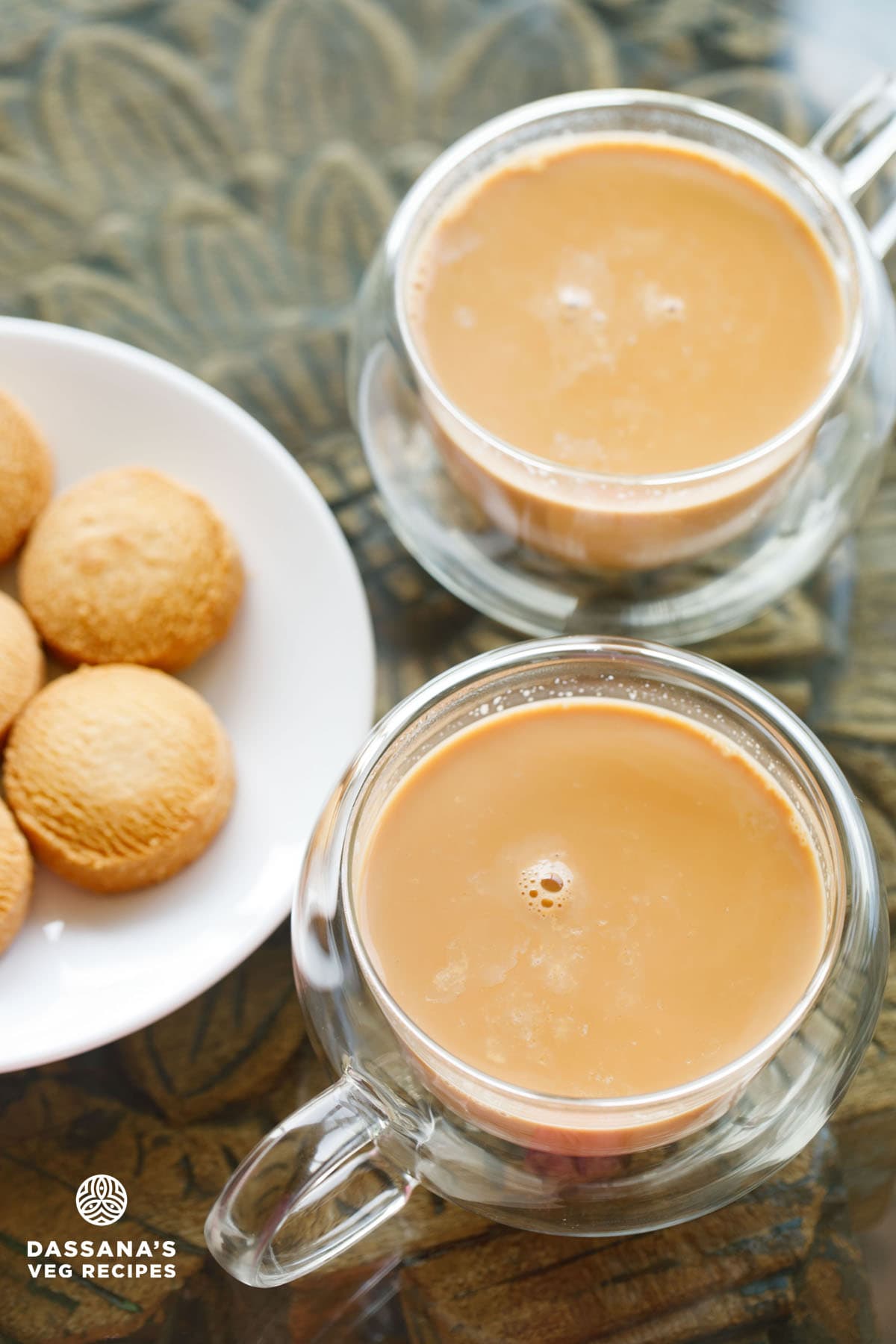
I have fond memories of sipping this creamy brew in old-world Irani cafés scattered across Mumbai and Pune.
Paired with a warm, butter-laden bun maska or the crustier brun maska, it was more than just chai. It was an experience, a quiet comfort I still turn to every now and then.
Table of Contents
What is Double Decoction in Irani Chai
In the context of Irani Chai, double decoction means preparing two separate concentrated brews:
- Tea Decoction: Strong black tea is simmered for a long time with spices like cardamom, cloves, and cinnamon in water. This creates a bold, intense tea concentrate.
- Milk Base: Separately, whole milk is simmered slowly with sugar until it becomes slightly thick and creamy.
These two are not boiled together. Instead, they are combined just before serving. This method helps maintain the strength of the tea and the richness of the milk, giving Irani Chai its distinct flavour and smooth texture.
Note: Technically, only the tea is a true decoction. The milk is simmered, thickened and sweetened, but not decocted in the traditional sense. While the term “double decoction” isn’t commonly used online for Irani Chai, it describes the method accurately; where both tea and milk are prepared separately and then combined just before serving.
How I Make Irani Tea
For that signature depth, I prefer using strong CTC (Crush-Tear-Curl) black tea; especially robust Assam, which brews into a bold, flavorful base. You can use loose tea leaves, but they yield a gentler, more delicate version of the Irani Tea.
I avoid overboiling the tea; instead, I let it gently simmer. Because I enjoy the slight edge of tannins as these add character.
I typically simmer the decoction on medium-low heat until it develops a dark amber hue, around 3 to 5 minutes. It’s just enough to extract the strength without overwhelming the cup of Irani Chai with bitterness.
Irani Tea is best enjoyed steaming, poured into small glass cups or classic cutting chai glasses that evoke the charm of heritage tea houses.
Is Dum Chai the same as Irani Chai?
There’s often some mix-up between Irani Chai and Dum Chai, especially online. You may come across blog posts or videos where both terms are used interchangeably. But they’re not exactly the same.
Irani Chai is made using a double-decoction method where the tea and milk are prepared separately and then combined just before serving. This gives the chai a smooth, balanced taste.
Dum Chai, on the other hand, is made by simmering tea, milk, and spices together in one pot, usually for a longer time, sometimes even in a sealed container. It’s often richer and heavier, and sometimes made with Khoya or cream.
Irani Chai and dum-style chai are entirely different preparations, each with its own unique method and cultural background. Irani Chai has its own identity, especially in the old Irani cafés of Hyderabad, Mumbai, and Pune.
How to make Irani Chai (Recipe)
Start by setting a saucepan of full-fat milk on the stove and let it gently simmer. This slow reduction is key to achieving that signature creamy richness in an authentic Irani Chai. As the milk begins to thicken and develop a slightly creamy hue, move on to the next step.
In a separate pan, bring water and crushed whole spices; like green cardamom, and optionally a clove or cinnamon to a simmer. Once the water is aromatic, add Assam CTC tea and let it bubble gently for a few minutes until you get a deep, bold brew.
When both the milk and tea are ready, strain the tea decoction and pour it into a cup of thickened milk. Stir gently, and your Irani Chai is ready to serve – smooth, aromatic and inviting.
For a more indulgent twist in the Irani Tea, you can stir in a bit of khoya (mawa) or sweetened condensed milk. Just remember to adjust the sugar accordingly, as these add extra sweetness and richness on their own.
Enjoy Irani Chai with Irani café classics like Bun Maska, Onion Samosa and Mawa Cake.
Prepare Thickened Milk
1. In a sauce pan, heat 2 cups full-fat or whole milk.
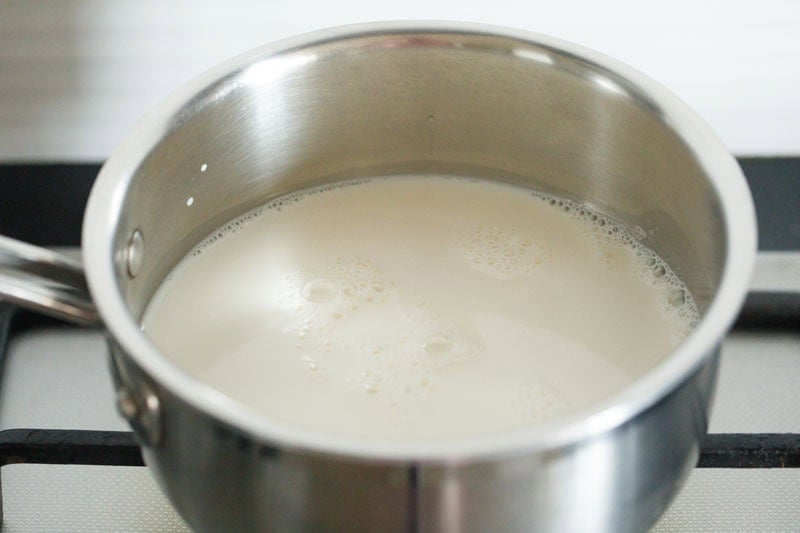
2. Bring it to a boil and simmer on low to medium-low heat, stirring occasionally to prevent burning. Let the milk reduce by about ¼, as this makes the milk richer and thicker.
This process takes around 15 to 20 minutes in total and makes the milk creamier, adding to the richness of the chai.
Use a wide pan for faster evaporation. Simmer gently, don’t boil as it helps prevent burning or over-thickening. Stir occasionally to avoid skin formation (malai) and scorching at the base.
You’ll know it’s reduced when the volume is down to 1.5 cups and the milk will look slightly creamier and richer in color.
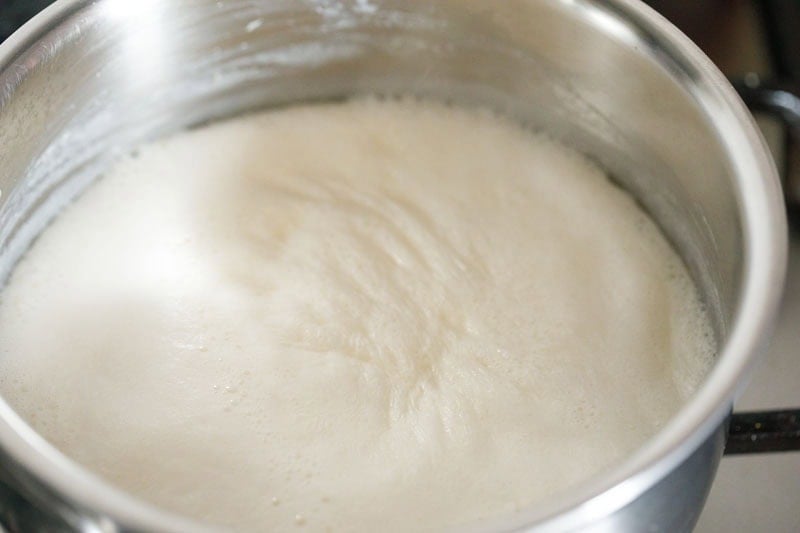
3. When the milk has reduced, add 4 tablespoons sugar and stir to dissolve.
Optional: Add a few drops of rose water or kewra water at the end for a floral aroma.
Keep milk on low heat so that it gently simmers and begin with making the tea decoction.
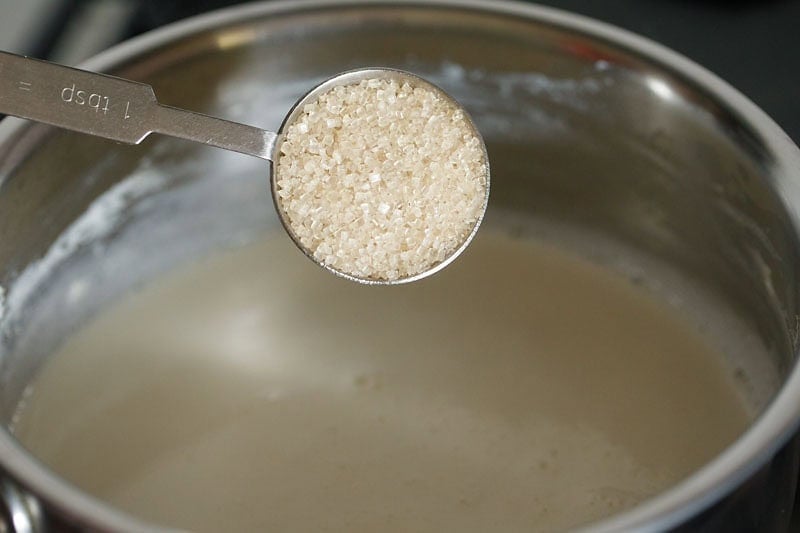
Make Tea Decoction
4. In a mortar, take 4 to 5 green cardamom pods, 3 cloves and ¾ inch cinnamon stick. Lightly crush these spices with a pestle.
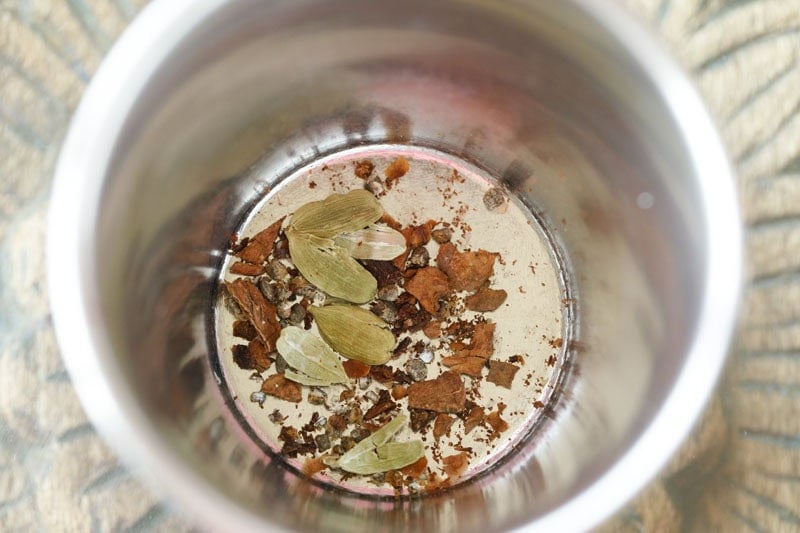
5. While the milk is simmering, in another saucepan, add 2½ cups water and the crushed spices.
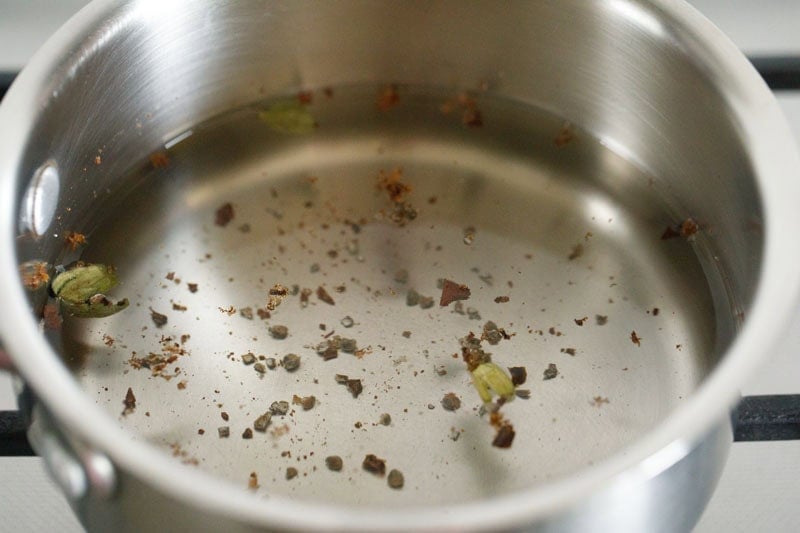
6. Bring the spiced water to a boil.
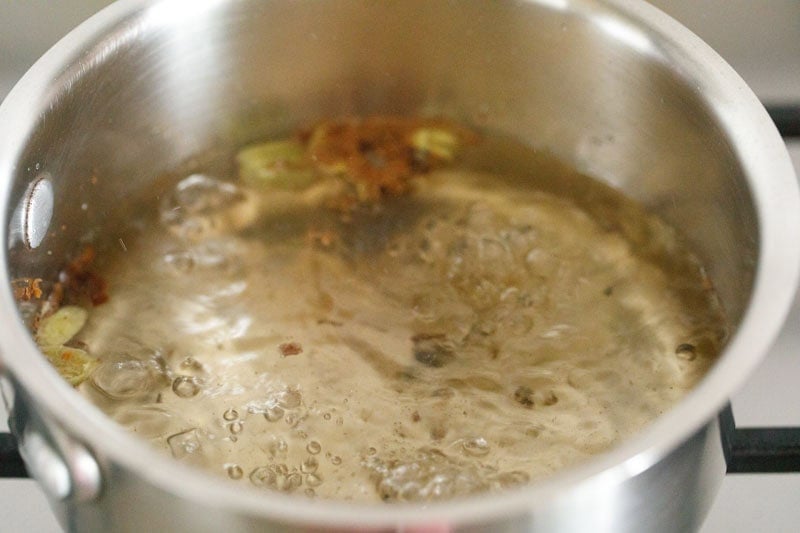
7. Add 3½ teaspoons of black tea.
Use Assam CTC for rich color and malty flavor. Light teas like Darjeeling won’t yield the deep hue and strength Irani Chai is known for.
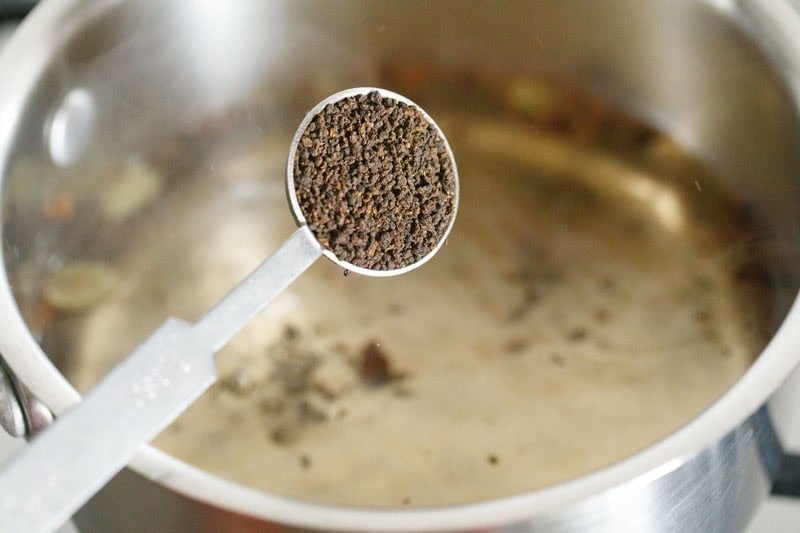
8. Simmer on low heat for about 3 to 5 minutes or until the water has a nice amber color.
If you want, you can strain and keep the decoction hot in a flask.
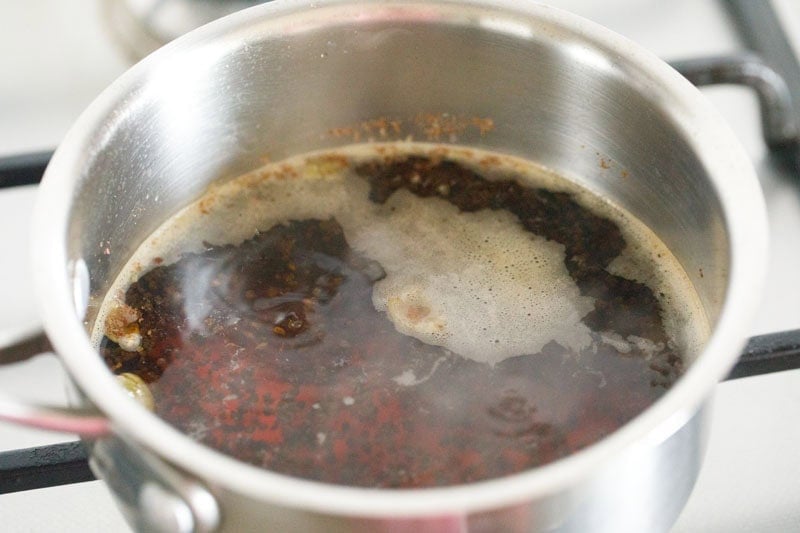
Assemble and Make Irani Tea
9. Once the tea decoction is ready, turn off the heat of the stovetop where the milk is simmering. Lift the saucepan and pour about ⅓ to ½ cup thick hot milk into a cup.
If you do not like the clotted cream (malai) in your chai, you can strain the milk.
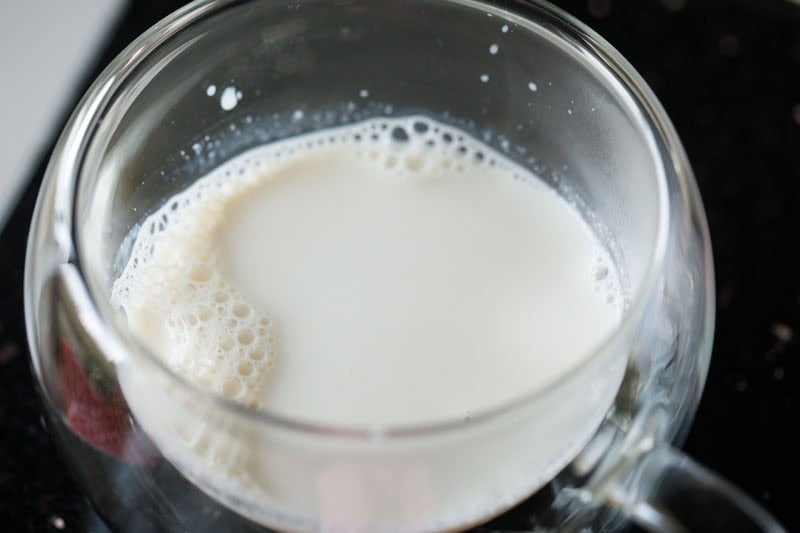
10. Take the saucepan with the hot tea decoction. Using a strainer, strain ¼ to ⅓ cup hot tea decoction in the cup with the thick milk.
Adjust to taste depending on how strong or milky you want your tea.
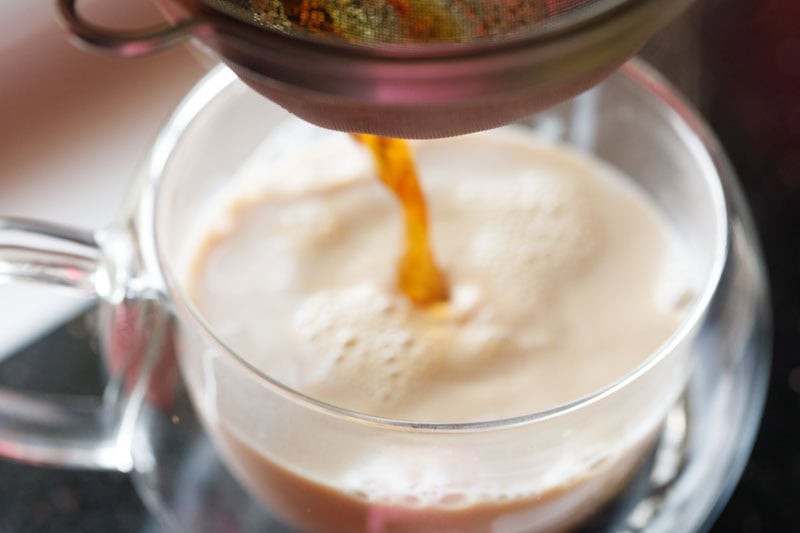
11. Stir gently and serve Irani Chai hot.
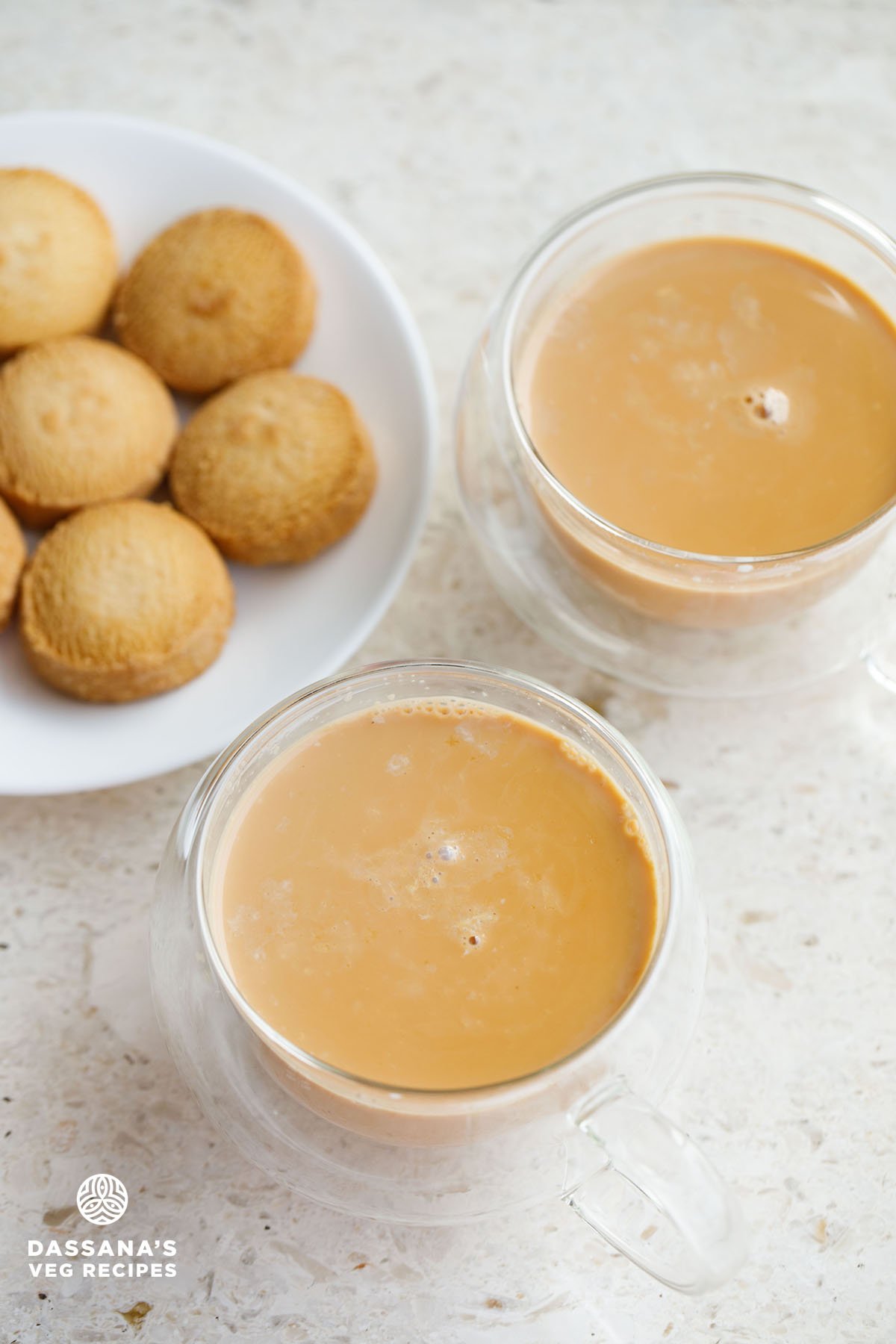
Serving Suggestions
Irani Chai isn’t just a beverage; it’s an invitation to pause and savor. And what better way to enjoy it than with some classic, time-honored accompaniments?
- Karachi Biscuits: Choose from almond-rich badam or fruity varieties for a luxurious nibble alongside your chai.
- Osmania Biscuits: Buttery, sweet-salty and utterly melt-in-the-mouth, these Hyderabad café legends are a must.
- Khari Biscuits: Light, flaky layers of puff pastry that add a satisfying crunch to every sip.
- Bun Maska: A soft milk bun slathered with butter. Dip it in your chai for the ultimate comfort bite.
- Maska Pav: A toasted pav roll, crisped with butter and sometimes a swipe of jam, for those who love a nostalgic twist.
Whether it’s a leisurely breakfast or an evening wind-down, these pairings turn a simple cup of Irani Tea into a moment worth savoring.
Serving Ideas For Guests
Create a charming tea tray to impress. Serve Irani Chai in a small glass cup or traditional cutting glass, nestled alongside two Osmania biscuits or your choice of baked treats, and a neatly sliced bun maska.
Want to add a modern flourish? Try garnishing the Irani Tea with a pinch of cardamom powder or a few crushed dried rose petals for a subtly aromatic twist.
Expert Tips
- Use full-fat milk: To achieve the signature richness Irani Chai is known for, full-fat milk is non-negotiable. Toned or skim milk just won’t give you the velvety body this chai demands. The creamier, the better.
- Go for strong Assam CTC tea: For that bold, malty depth and the beautiful reddish-brown hue, choose robust Assam CTC (Crush-Tear-Curl) tea. It holds up well to the long simmer and cuts through the creaminess. Skip light-bodied teas like Darjeeling or any flavored blends as they lack the punch needed here.
- Slow-reduce the milk: Let the milk gently simmer on low heat until it reduces by about 20 to 25%. This slow evaporation intensifies the creaminess and gives the tea its signature creamy texture.
- Brew the decoction separately: Steep the tea leaves in water with a touch of cardamom, and optionally, clove or cinnamon for a whisper of warmth. Avoid boiling the tea leaves directly in milk as it muddies the flavor and compromises clarity.
- Adjust sweetness: The sweetness of Irani Tea can vary from mildly sweet to decadently sugary, depending on your preference. Traditionally, a generous amount of sugar is added to the milk while it simmers, which balances the strong decoction beautifully.
More Tips
- Alternative sweeteners: Jaggery or unrefined cane sugar can offer a more earthy sweetness, though they may slightly alter the color.
- Strain for a smooth sip: Straining both the decoction and the milk (especially if it’s developed a layer of malai) ensures a clean, silky finish.
- Combine just before serving: Pour the tea decoction into the reduced milk, not the other way around. This allows you to control the balance of strength and creaminess with each cup.
- Optional aromatics: For a luxurious touch, stir in two to three drops of rose water or kewra essence just before serving – an homage to the old Irani cafés where aroma was as important as taste.
- Vegan Options: For a vegan version, try almond or cashew milk, but simmer gently as they thicken differently than dairy.
FAQs
What is special about Irani Chai?
Irani Chai stands out for its creamy, indulgent texture and bold tea flavor. Unlike spiced masala chai, it’s not overloaded with spices, but instead, it focuses on the luxurious blend of slow-simmered full-fat milk and strong Assam CTC tea decoction. The milk is reduced until rich and velvety, while the tea is brewed separately for depth and clarity.
Which state is famous for Irani Tea?
Telangana, especially Hyderabad, is most famous for Irani Chai. The city’s heritage Irani cafés are legendary, known for serving this creamy brew with Osmania biscuits. However, Maharashtra (notably Mumbai and Pune) also boasts a rich tradition of Irani cafés where this special tea continues to be a popular choice.
What is the difference between Irani Tea and tea?
The main difference lies in the preparation and richness:
Irani Tea is made by slowly reducing full-fat milk until thick and creamy, then combining it with a strong tea decoction. It’s occasionally scented with cardamom or rose water/kewra water for aroma.
Regular Indian chai usually involves boiling tea leaves with milk, water, sugar and sometimes spices all together in one pot.
Irani Tea is smoother, silkier and has a deeper flavor with less spicing compared to the typical masala chai.
What is the history of Irani Chai?
Irani Chai traces its roots back to the early 20th century, brought to India by Iranian immigrants, particularly Zoroastrians, who settled in cities like Hyderabad, Mumbai (then Bombay) and Pune. They established charming Irani cafés, which became cultural icons and community hubs. These cafés served unique tea with influences from Persian and Indian traditions. Thus, was born Irani Chai, a symbol of cross-cultural fusion and comfort.
Explore More Homemade Tea Variations
Step by Step Photo Guide Above
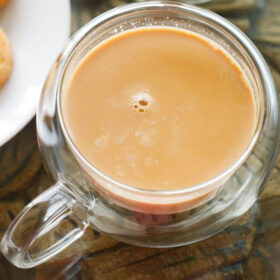
Irani Chai Recipe – Classic Irani Tea
Ingredients
For Tea Decoction
- 2 cups water
- 3½ teaspoons black tea – CTC dust or Assam tea leaves
- 4 to 5 green cardamoms – lightly crushed
- 3 cloves – lightly crushed
- ¾ inch cinnamon stick – optional, lightly crushed
For Milk Base
- 2 cups whole milk
- 4 tablespoons sugar – or adjust to taste
- 2 to 3 drops of rose water or kewra water – optional
Instructions
Prepare Thickened Milk
- In a saucepan, heat full-fat milk or whole milk.
- Bring it to a boil and simmer on low to medium-low heat, stirring occasionally to prevent burning.
- Let the milk reduce by about ¼ over low to medium-low heat. This process takes around 15 to 20 minutes in total and makes the milk richer and slightly thicker, enhancing the creaminess of the chai.
- You'll know the milk is reduced when the volume is down to 1.5 cups and the milk will look slightly creamier and richer in color.
- Once the milk has reduced and thickened, add sugar to it and stir to dissolve.
- Optional: Add a few drops of rose water or kewra water at the end for a floral aroma.
Make Tea Decoction
- Take the spices – cardamom, cloves and cinnamon in a mortar. Crush these lightly with a pestle.
- Meanwhile when the milk is simmering, in another saucepan, take water and the crushed spices.
- Bring this water added with the spices to a boil.
- Add black tea and simmer on low heat for about 3 to 5 minutes or until the water has a nice amber color.Opt to strain and keep the tea decoction hot in a flask if you prefer.
Make Irani Chai
- Once the tea decoction is ready, turn off the heat of the stovetop where the milk is simmering. Lift the saucepan and pour about ⅓ to ½ cup thick hot milk into a cup.
- Take the saucepan with the hot tea decoction. Using a strainer, strain ¼ to ⅓ cup hot tea decoction in the cup with the thick milk. Adjust to taste depending on how strong or milky you want your Irani Chai.
- Stir gently and serve Irani Chai hot. Prepare Irani Tea this way in for more servings.
Serving Suggestions
- Irani Chai is best served hot, paired with Osmania biscuits, bun maska, or khari biscuits.
- It also goes well with simple bakery-style cakes or rusk for a classic chai-time experience.
Notes
- The tea decoction simmered separately and the milk thickened separately is the key.
- Some Irani cafés in Hyderabad use khoya or malai for a richer mouthfeel. You can stir in 1 to 2 teaspoons of khoya at the end for a more indulgent version.
- Use full-fat milk for a creamy and rich texture.
- Simmer the tea decoction for about 3 to 5 minutes for balanced flavor and ensuring the tea does not become bitter.
- Don’t boil the milk and tea together. Prepare them separately and mix just before serving.
- Lightly crush the cardamom and cloves to release their aroma into the decoction.
- Strain both the tea and milk before combining for a smooth finish.


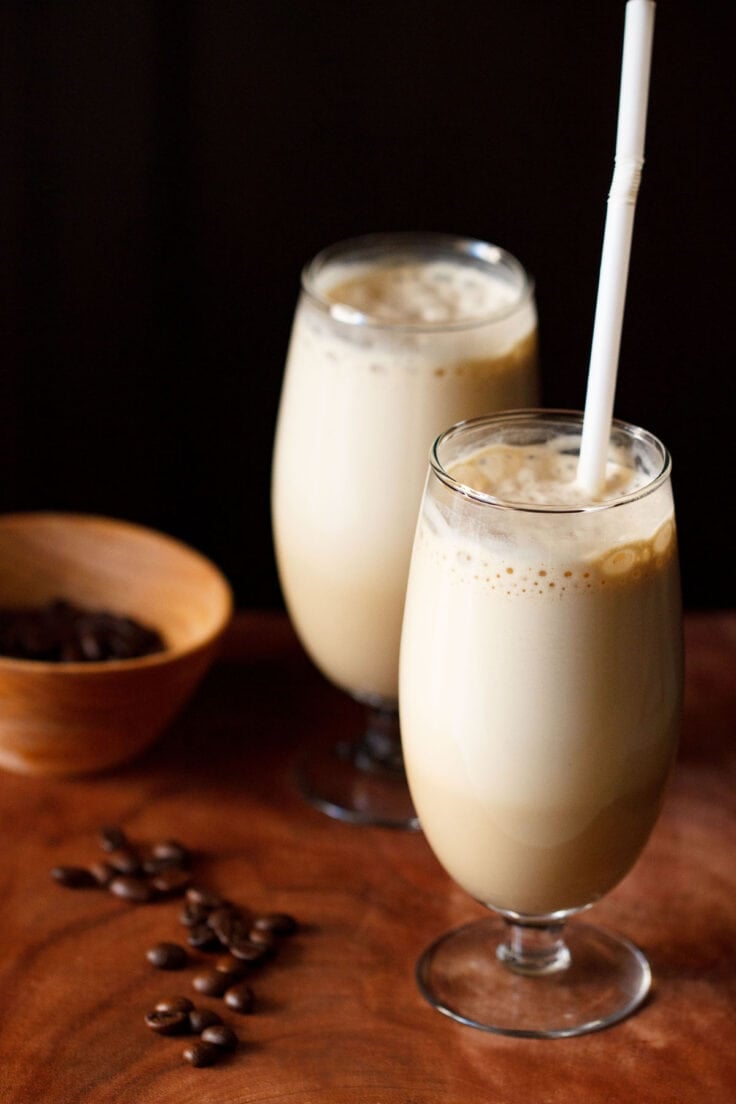
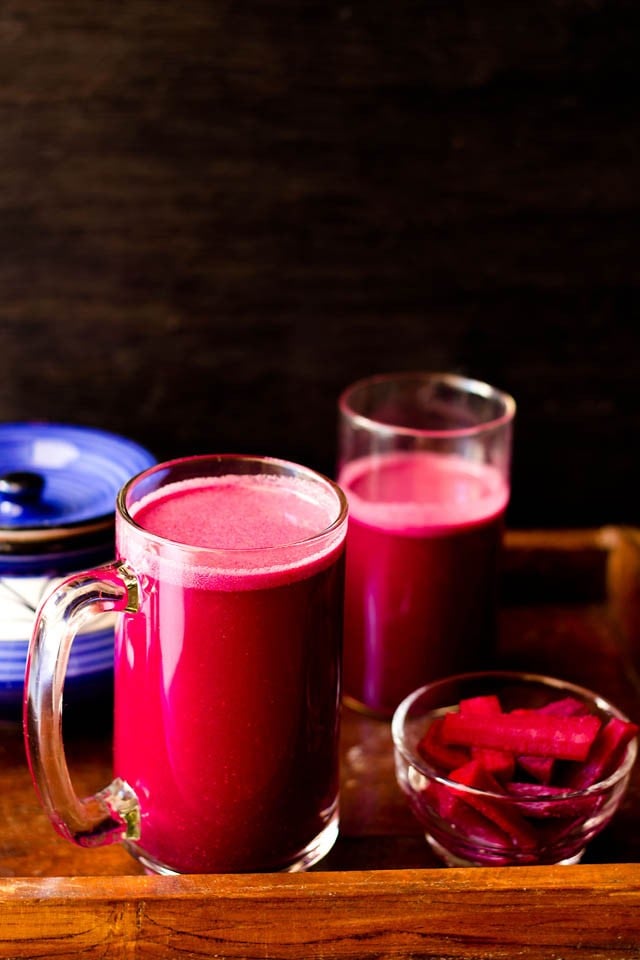
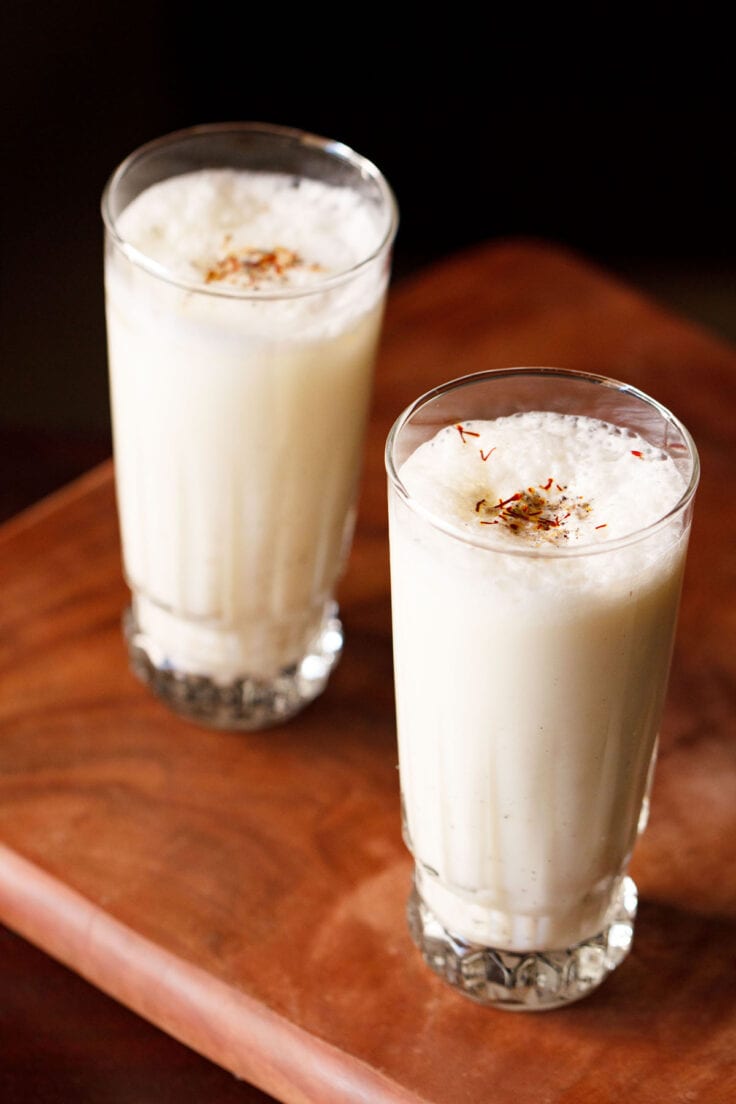

What a lovely recipe. Increased the proportions and made it for my friends and paired the chai with your Bun Maska recipe. They loved it. Thanks for both the recipes.
That’s wonderful to hear. So glad you and your friends enjoyed the Irani Chai and Bun Maska. They really do make a great combination. Thanks for sharing your feedback.
Can I make this chai with a plant-based milk?
Yes, you can. Just use a creamy plant-based milk like oat, soy, or cashew milk or a barista style one. They work well and give a good consistency. Just be sure to simmer gently so it doesn’t split.